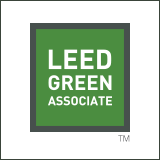
LEED® v4 Green Associate Exam Prep Webinar Series
GreenCE’s mission is to support the necessary transition to a sustainable built environment by empowering design professionals to address the environmental, economic, and social impacts of buildings. GreenCE’s course catalog includes LEED exam preparation, continuing education to maintain your AIA or LEED credential, as well as specialty education focused on topics such as ADA/Barrier-Free requirements. We are committed to designing the highest quality continuing education programs in the construction industry.
Tuesday, April 12, 2016 - 4:00pm to 6:00pm EDT
Become a LEED Green Associate through this exciting in-depth review of the LEED v4 rating system. This webinar series includes a study guide, hundreds of practice questions, study sheets, access to an online anytime course, and a Certificate of Completion for 8 AIA HSW Hours. The program includes tips and study methods to pass the exam the first time. Learn how to pass the LEED exam from the #1 USGBC Education Partner.
FOUR PART WEBINAR SERIES:
Green Principles & the LEED® v4 Green Associate Exam
8 AIA HSW CE Hours | Course: GGA00F | Provider: GreenCE, Inc.PART 1
PART 2
PART 3
PART 4
DATE:
Tues. April 12
Thurs. April 14
Tues. April 19
Thurs. April 21
TIME:
- 4-6 p.m. ET
- 4-6 p.m. ET
- 4-6 p.m. ET
- 4-6 p.m. ET
Attendees must complete all 4 parts of the webinar series to receive credit and Certificate of Completion. Make-up sessions are allowed.
- By completing this course, you will be able to:
- 1. Explain the various LEED rating systems, categories, and minimum program requirements.
- 2. List the requirements, strategies and intent of each credit in LEED v4 for New Construction
- 3. Identify the core concepts and define key terms behind green building.
- 4. Differentiate between the many referenced standards used by LEED v4, such as ASHRAE Standard 90.1-2010, Green-e Energy product certification, and the California
- 5. Department of Public Health Standard Method v1.1-2010.
- 6. Identify best practices for achieving a sustainable project site, such as site selection, reducing building footprint and restoring native vegetation, to reduce impact to the environment.





